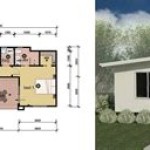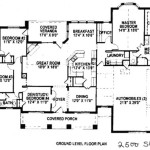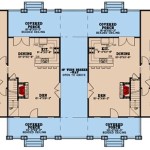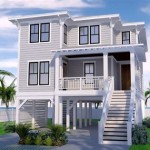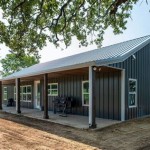Economical 4 Bedroom House Plans: Maximizing Space and Value
The pursuit of homeownership often involves navigating a complex landscape of costs and compromises. For families requiring ample living space, the desire for a four-bedroom house can present a significant financial hurdle. Choosing economical four-bedroom house plans becomes paramount for prospective homeowners seeking to balance space needs with budgetary constraints. These plans prioritize efficient layouts, cost-effective materials, and streamlined construction processes, ultimately offering a viable path toward achieving the dream of owning a spacious and functional home without incurring excessive expenses.
The definition of "economical" in this context extends beyond simply minimizing the initial purchase price. It encompasses long-term cost considerations such as energy efficiency, reduced maintenance requirements, and the potential for future modifications. An economical house plan is one that provides the necessary living space in a way that is both affordable to build and sustainable to maintain over time. This requires careful planning and a strategic approach to design and construction.
The success of an economical four-bedroom house plan hinges on several key factors. These include optimizing the floor plan to minimize wasted space, selecting affordable and durable building materials, and incorporating energy-efficient design principles. Furthermore, a well-designed plan will consider the specific needs and lifestyle of the occupants, ensuring that the house is not only affordable but also comfortable and functional.
Understanding the Key Elements of Economical House Plans
Economical house plans are not simply smaller or less aesthetically pleasing versions of larger, more expensive homes. Instead, they represent a deliberate effort to maximize value by carefully considering every aspect of the design and construction process. Understanding the core elements of these plans is essential for anyone seeking to build a four-bedroom house on a budget.
One crucial element is the efficient utilization of square footage. Economical plans avoid unnecessary hallways and oversized rooms, opting instead for open-concept living spaces and strategically placed storage areas. The layout should prioritize functionality, ensuring that each room serves a specific purpose and contributes to the overall flow of the house. Minimizing the building's footprint also contributes to cost savings, as it reduces the amount of materials required for the foundation and roof.
Another key element is the selection of cost-effective building materials. This does not necessarily mean choosing the cheapest options available, but rather selecting materials that offer a balance of affordability, durability, and aesthetic appeal. For example, using readily available lumber grades, engineered wood products, and affordable siding options can significantly reduce construction costs without compromising the structural integrity of the house. Similarly, selecting energy-efficient windows and doors can lead to long-term savings on heating and cooling bills.
Finally, economical house plans often incorporate simple, streamlined designs. Complex architectural features, such as intricate rooflines or elaborate trim details, can add significantly to the overall cost of construction. Opting for a simpler, more straightforward design can help to reduce labor costs and material expenses, while still creating a visually appealing and functional home. This simplicity can also translate to easier maintenance and repairs in the future.
Strategies for Optimizing Space and Reducing Costs in 4 Bedroom Designs
Achieving an economical four-bedroom house design requires a strategic approach to space planning and cost reduction. Several techniques can be employed to maximize the functionality of the house while minimizing construction expenses.
One effective strategy is to prioritize open-concept living areas. Combining the kitchen, dining room, and living room into a single, open space creates a sense of spaciousness and eliminates the need for separate walls and doors. This can significantly reduce construction costs and improve the flow of the house. Strategic placement of furniture and carefully chosen lighting fixtures can then define distinct zones within the open space.
Another important consideration is the size and layout of the bedrooms. While four bedrooms are essential for accommodating a growing family, it is important to avoid making them unnecessarily large. Standardizing the size of the bedrooms can simplify the construction process and reduce material waste. Additionally, incorporating built-in storage solutions, such as closets and shelving, can maximize the use of space and eliminate the need for bulky furniture.
Efficient use of vertical space can also contribute to cost savings. Building a two-story house, rather than a sprawling ranch-style home, can reduce the building's footprint and minimize the amount of foundation and roofing required. This can also lead to lower heating and cooling costs, as a two-story house typically has a smaller surface area exposed to the elements. However, it's essential to consider accessibility and the potential need for future modifications when designing a two-story house.
Furthermore, consider incorporating shared bathroom spaces. A "Jack and Jill" bathroom, accessible from two bedrooms, can be a space-saving and economical solution. This eliminates the need for two separate bathrooms, reducing plumbing costs and material expenses. Careful planning is necessary to ensure privacy and functionality for all occupants.
Finally, consider the orientation of the house on the lot. Optimizing the orientation to maximize sunlight exposure can reduce the need for artificial lighting and heating, leading to long-term energy savings. Similarly, strategic landscaping can provide shade and wind protection, further reducing energy consumption. These simple design choices can have a significant impact on the overall cost of homeownership.
Material Selection and Energy Efficiency in Economical House Construction
The choice of building materials plays a crucial role in determining the overall cost and energy efficiency of a four-bedroom house. Selecting affordable, durable, and energy-efficient materials is essential for achieving an economical and sustainable home.
For framing, consider using readily available lumber grades or engineered wood products such as oriented strand board (OSB) or laminated veneer lumber (LVL). These materials offer comparable strength and durability to more expensive lumber options and can often be installed more quickly, reducing labor costs. When choosing siding, explore options such as vinyl siding, fiber cement siding, or engineered wood siding. These materials are generally more affordable than brick or stone and offer excellent weather resistance and low maintenance requirements.
Window selection is another critical factor in energy efficiency. Opt for energy-efficient windows with low-E coatings and insulated frames. These windows can significantly reduce heat loss in the winter and heat gain in the summer, leading to lower heating and cooling bills. Consider the climate when selecting windows, as different climates require different window types and coatings. Double-pane windows are a minimum requirement in most climates, while triple-pane windows may be beneficial in colder regions.
Insulation is also essential for maintaining a comfortable and energy-efficient home. Insulate walls, ceilings, and floors to recommended R-values for the local climate. Consider using a combination of insulation types, such as fiberglass batts, spray foam insulation, and rigid foam insulation, to achieve optimal thermal performance. Air sealing is also crucial for preventing air leaks and drafts, which can significantly reduce energy efficiency. Seal around windows, doors, and any other penetrations in the building envelope.
Finally, consider incorporating energy-efficient appliances and lighting. Choose Energy Star-rated appliances, which use less energy than standard appliances. Switch to LED lighting, which uses significantly less electricity than traditional incandescent or fluorescent bulbs. Installing a programmable thermostat can also help to reduce energy consumption by automatically adjusting the temperature when the house is unoccupied.
By carefully considering material selection and energy efficiency, prospective homeowners can build a four-bedroom house that is both affordable to construct and sustainable to maintain over the long term. A well-designed economical house plan is an investment in the future, providing a comfortable and functional living space while minimizing the financial burden of homeownership.

Best 25 4 Bedroom House Plans Ideas On Beach

Building On The Affordable House Plans Of 2024 Houseplans Blog Com

Budget Friendly 4 Bed House Plan 55150br Architectural Designs Plans

Affordable 4 Bed House Plan With Impressive Layout 83906jw Architectural Designs Plans

Est House Plans To Build Simple With Style Blog Eplans Com

Est House Plans To Build Simple With Style Blog Eplans Com

Low Cost Single Story 4 Bedroom House Floor Plans Country Farm 2200 Sf Basement One

Economical Four Bedroom House Plan 4 Plans Ranch

House Plan 4 Bedrooms 1 Bathrooms 3314 Drummond Plans

Building On The Affordable House Plans Of 2024 Houseplans Blog Com


